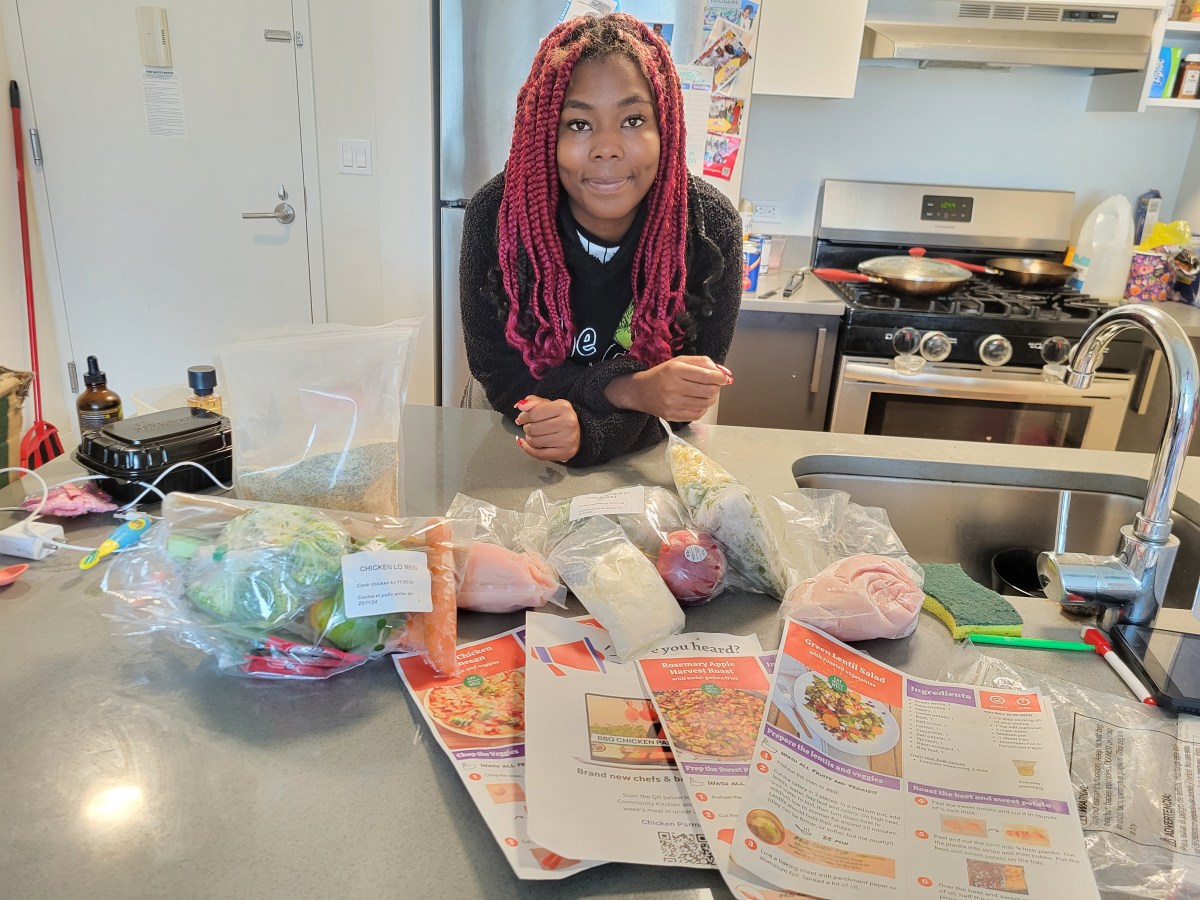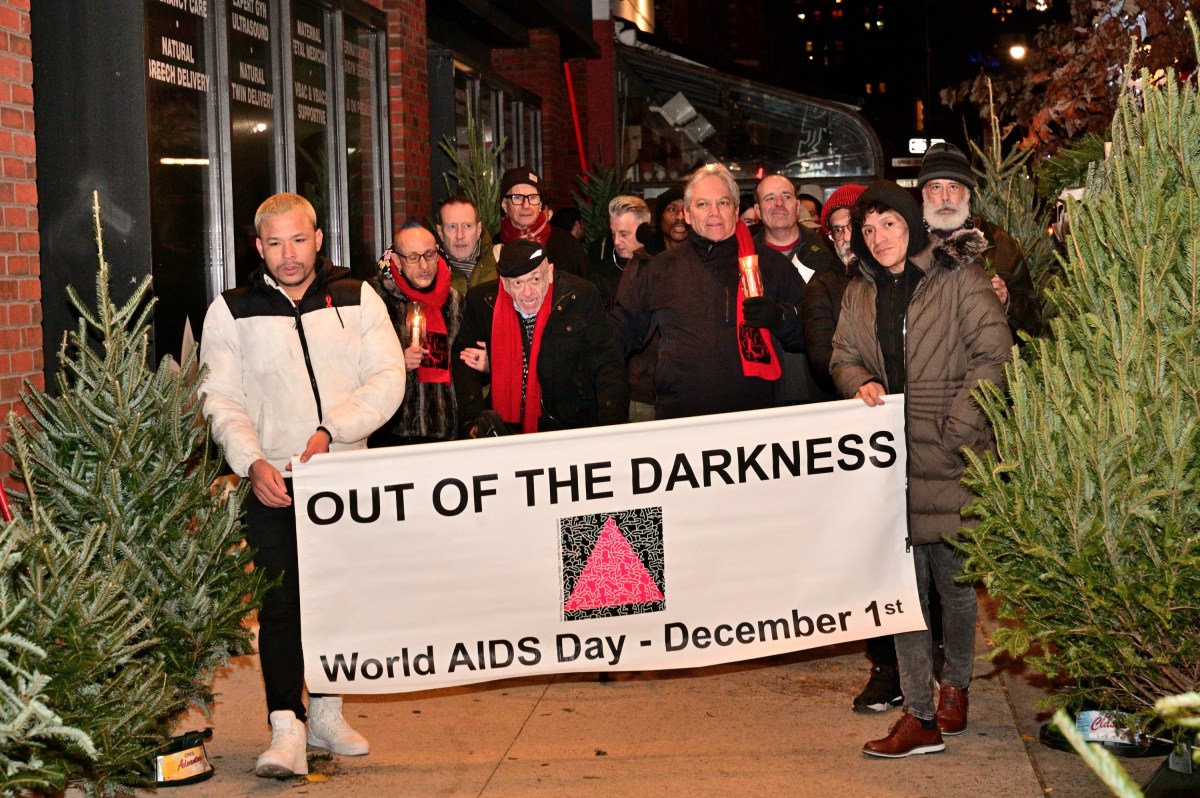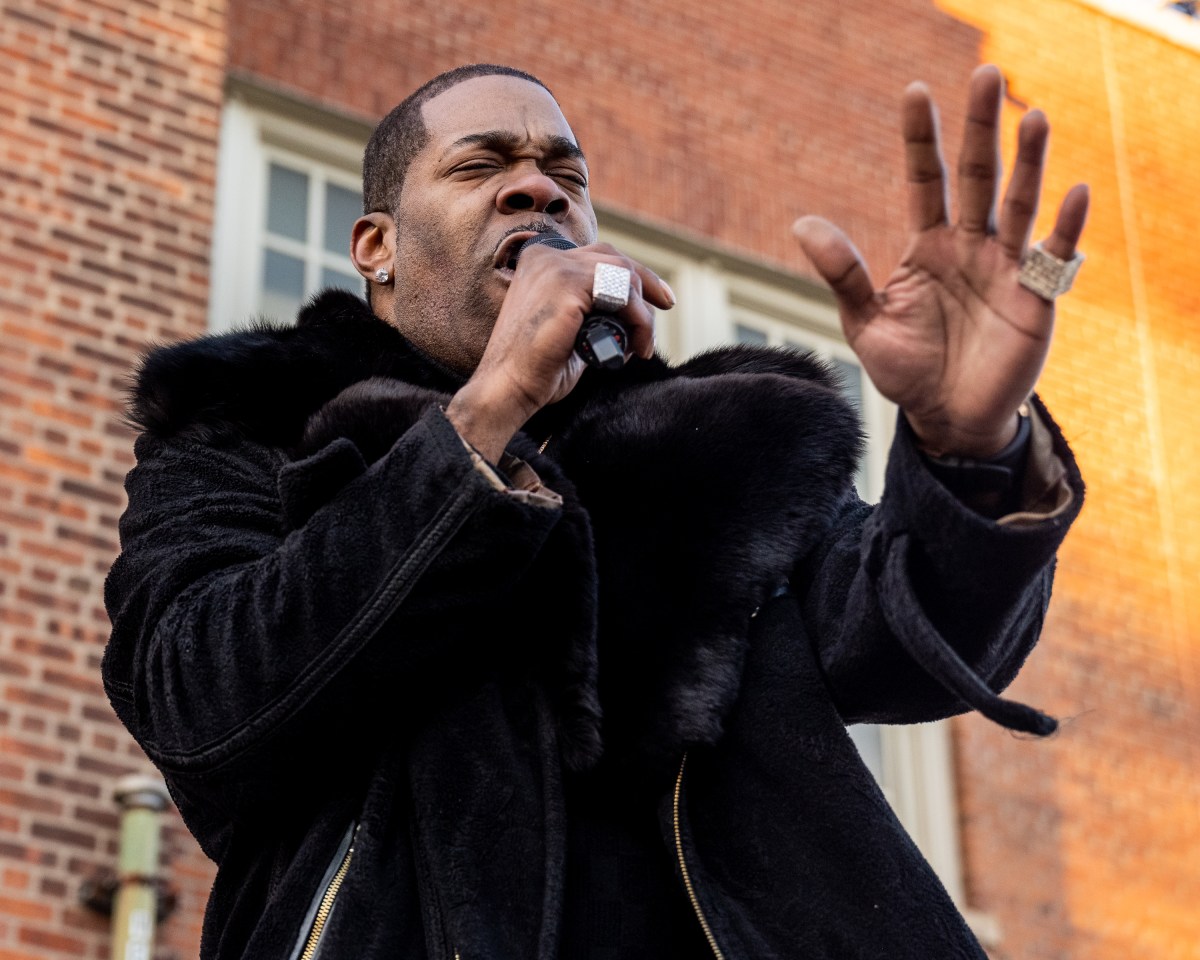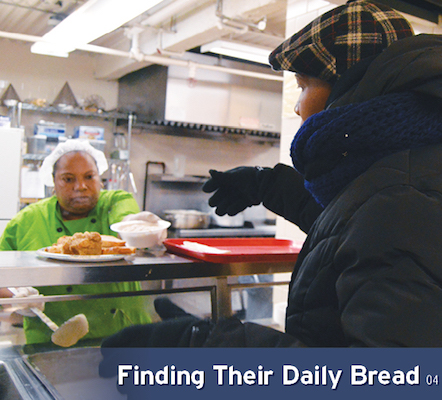
BY JACKSON CHEN | Just steps from the northeastern-most point of Central Park, the hungry are welcomed in and away from February’s icy winds on the Upper East Side. Around 100 or so people looking for a free meal find their way to the New York Common Pantry on a frigid Friday morning.
Across Midtown and the Upper East and Upper West Sides, New York Common Pantry is one of more than a dozen places that offer the homeless much-needed free meals. As local politicians have recently worked overtime trying to address the homelessness problem in the city on a macro level, pantries and soup kitchens open up day in and day out to stem the bleeding of a problem seen throughout the city’s streets.
A line of mostly middle-aged men extends outside the pantry’s entrance at 8 East 109th Street, and inside it snakes slowly until reaching the servers stationed outside the kitchen. The breakfast varies each day from Monday through Friday — dinner is served Mondays, Wednesdays, and Fridays starting at 4:30 p.m. — but usually consists of sandwiches, pastries, oatmeal, toast, condiments, and some milk or juice.
Once the patrons fill their plastic trays, they find their seats and begin their meal. Elevator jazz is turned on by Marvin Wells, the police officer-turned-pantry security guard, and he informally chats with some of the guests.
According to Wells, the pantry can see as many as 150 people a day looking for a free breakfast. He added that around the start of each month, the numbers usually take a small dip because that’s when people cash their monthly assistance checks.
The pantry dining area maintains an amiable feel, with Wells patrolling the area with a friendly demeanor. But, the security is needed for more than just firm handshakes and hearty smiles.
An abrupt spat arose when a guest attempted to take what seemed to be an unattended sandwich off a table. Followed by curt demands to put it down, the misunderstanding continued as the would-be poacher requested less attitude from the sandwich’s owner.
On other days, misunderstandings can be as simple as someone sitting on a hat absentmindedly left on a chair. When the man said that he just wanted to get his hat back, his words were lost on someone who couldn’t understand English. Growing annoyed and raising his volume, he eventually was able to snatch his hat back from under the other man.
While the complications tend to de-escalate quickly in the pantry, arguments that arise among homeless New Yorkers in other settings can oftentimes be much worse, according to Kevin S.
Kevin, a homeless man who was eating just seats away from the minor altercation, said if the same situation happened in a homeless shelter, it would’ve likely led to a fight. As someone who’s alternated between the city’s homeless shelter system and roughing it out on the streets for around 10 years, he likened shelters to “an extension of jail.”
According to Kevin, his personal belongings had to be in his line of sight at all times and minor daily nuisances could lead to physical confrontations. He recalled incidents where shelter residents would leave their wet clothes in a washing machine for too long.
“Nah, you can’t do that, a fight will break out over that,” Kevin explained. “It’s a lot of simple stuff that’s thrown out of proportion.”
During one of his shorter shelter stints, he said, he saw one resident assault another with a fire extinguisher. Similar stories of violent outbursts, mental health problems, and rampant drug use were shared, as well, by Mike Capers, homeless after losing his job last October; Cynthia W., who is going on six months in the shelter system; Theresa D., who is dealing with mental health issues and living in a less-than-legal apartment setup; and the Professor, who is now living in reduced-cost housing after two years in the system.
Most guests at the food pantry, when asked their view of city homeless shelters, explained they would rather be out on their own.
“You get a roof over your head and you’re not out in the streets,” Kevin said of the shelters. “But you still got the streets within the vicinity. I’d rather be out here in the streets in the cold.”
Separating himself from the homeless population of 60,096 living in the city’s shelter system — according to the Coalition for the Homeless’ December 2015 count — Kevin sought personal freedom on the streets, where the numbers are harder to gauge.
To get a rough estimate of the homeless currently living on New York’s streets, the city’s Department of Homeless Services performed its annual count, the Homeless Outreach Population Estimate or HOPE, on February 8. While this year’s HOPE numbers won’t be released for several months, DHS tallied 3,182 people living on the streets, parks, subways, or other public spaces in its February 2015 survey. The year prior to that, volunteers counted 3,357 homeless living on the streets.
Though those numbers suggest a downward trend, there’s growing conviction everywhere from the streets to the offices of city government, non-profits, and the media that homelessness is on the rise. With the homeless especially visible in cold weather months, officials have jumped on the issue, arguing they are committed to tackling it head-on.
The biggest splash came in early January when Governor Andrew Cuomo issued a directive to take homeless people off the streets when the temperature dips below 32 degrees, an action that suggested people would be forced into the city shelter system. The executive order took effect on January 5 and is due to remain in force until March 12.
The governor’s initiative seemed to be one more slap at Mayor Bill de Blasio, who on December 15 had committed to a 90-day review of the city’s homeless services. Cuomo’s order, in the view of the de Blasio administration, was redundant and might even create legal hiccups regarding the right of the homeless to refuse to go into a shelter. According to de Blasio’s spokesperson Karen Hinton, who spoke to a number of news outlets, the mayor’s office supported the intent of the executive order, but believed that forcibly removing homeless people from the streets, even in freezing weather, would require a change in state law.
De Blasio faced pressure from other quarters, as well, when City Comptroller Scott Stringer, on December 18, released an audit showing violations at 87 percent of city shelters and a record number of people living in them, including around 23,000 children.
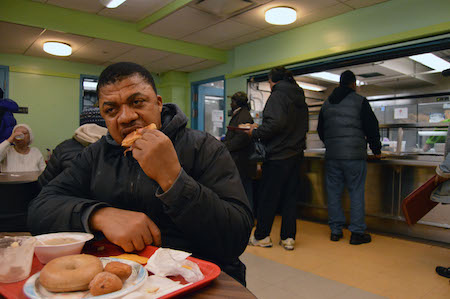
Away from the podiums and the cameras, others are taking a more personal, on-the-ground approach in trying to decrease homelessness.
Rob Byrnes, president of the East Midtown Partnership, agreed there was a need for shelter reform, but emphasized a more pressing absence of adequate programming specifically addressing the mental health problems and drug addiction that plague so many in the homeless population.
According to Byrnes, the solution isn’t as simple as bringing people into shelters. Many shelters are already overstuffed, and residents coerced into entering them are often quick to flee what they perceive as a dangerous environment, he said. The outreach teams from the partnership as well as the Bowery Residents Committee, he said, try to avoid treating homeless people they encounter as though they’re subject to a government edict, but instead work to understand the people behind the issue.
“There isn’t a blanket one-size fits all to deal with what are essentially 50-some odd thousand individual stories and situations,” said Byrnes, who described a seemingly idyllic solution of serving each homeless person with one-to-one interactions through dedicated and persistent caseworkers.
“There are some very resistant individuals out there, and the approach has to be tailored individually for each one,” he said, adding it took a full year to persuade one of their clients to receive help.
The distrust about accepting agency help runs deep in the homeless population. After being tossed from agencies to organizations to departments, Kevin said he was left with the sense that he was dealing with a system where any given entity’s ability to get funding influenced every single encounter he had with them. There is a serious flaw, he argued, in the way government looks at the situation he finds himself in, which he prefers to describe as being “in between places.” In trying to get help, however, he learned that he never quite fit the bill of being “homeless.”
Kevin works maintenance with a tour bus company, and having no place of his own to stay he sometimes spends the bulk of the rest of the day visiting an old friend in a nursing home. He said he’s sometimes been advised to quit his job as he seeks some sort of adequate shelter.
“There’s different levels of homelessness, and they only look at one level,” Kevin said of his past attempts at seeking assistance. “If you have a job or are somewhat employed, it seems like you don’t get no kind of help.”
Many people who have never experienced homelessness hold on to the common image of a homeless man or woman as a jobless beggar who got there on their own accord. While there are cases of “bad eggs” in the system, experts agree, most of the homeless are people who hit an awful streak of bad luck, according to the Professor. Many who fall into the pit of being homeless have no idea how to locate the rope to lift themselves out.
For Mike Capers, the New York Common Pantry guest who was fired from a courier job due to disagreements with his supervisor, his best option was couch-surfing with buddies willing to lend a hand. But he wasn’t able to stay extended periods of times because, as he put it, “you get that look” from hosts with whom you’ve overstayed your welcome.
Like Kevin, Capers found little success with the housing assistance programs he sought out, except for the promise of something down the road.
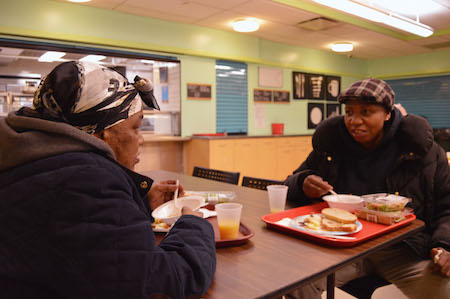
For Theresa D., as well, assistance has been slim while the need, given her mental health challenges, is great. Her current living situation means she could be easily evicted at any moment, but she explained she’s been round and round the revolving door of government help.
“They lead you to the water, but there’s no drinking when you get there,” Theresa said.
With government and non-profit groups struggling to get and keep their arms around the homelessness problem, it’s often the food pantries and soup kitchens that pick up the slack on the most pressing of needs — temporary relief in the form of hot meals.
With growing attention to the unaddressed challenges endured by so many homeless city residents, some local elected officials are now stepping up to create what they see as a needed bridge among the efforts already being waged by religious and other nonprofits and city agencies. On February 8, City Councilmembers Ben Kallos and Dan Garodnick teamed up with State Senator Liz Krueger and Borough President Gale Brewer to create the Eastside Taskforce for Homeless Outreach and Services, or ETHOS.
Besides providing a cheat sheet to all the pantries and soup kitchens in the area, Kallos said the task force will take responsibility for connecting such organizations with city resources, like the discretionary funding the councilmembers have at their disposal. And, he said, it will work to make certain that social services and meals providers and relevant city agencies are all aware of what each other is doing. Even if resources are not adequate to the need, the thinking goes, at least people should not suffer for lack of information about what is available.
As ETHOS works to rationalize the fight against homelessness on the East Side, the most determined among the homeless population continue struggling to better their own situation.
Leaving Common Pantry, Kevin said he was on his way to a nonprofit social services organization called Common Ground (which in fact recently became known as Breaking Ground), whose goal is the creation of housing for homeless New Yorkers. Still, given a long time without stable housing, he was not upbeat.
“I’m still going to try, but I guarantee I’m going to waste my time,” Kevin said.
As other Common Pantry guests were on their way out as the breakfast concluded at 9:30, some seemed ashamed, sullen, or indifferent, others determined to hold on to hope that they can turn a corner on their current problems.
Capers was the most hopeful among those at the New York Common Pantry that day. He has visions of becoming the next big stand-up comedian, and his current plight is all part of his story. A cold winter on the streets, endless couch-surfing, and agency run-arounds, he said, would all serve to build a unique comic narrative one day.
Even when people don’t have any money in their pockets, Capers insisted, they can still laugh. And, he still does himself, despite his bad luck.
“I may be homeless,” Capers said. “But I’m not in a predicament where I don’t have hope.”




